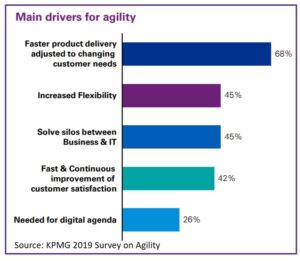
As part of our continuing series of blogs around the importance of the customer and employee journey, Niall and Steve explore the growing role of Agile.
Organisations are increasingly turning to Agile to compete with smaller, more nimble players who are frequently also using the technique. Meeting the needs of the end customer is often the key  goal of Agile teams as they push innovation boundaries (see chart). If the organisation has not already made the move to a focus on the customer journey, then Agile lends itself to this orientation and many implementations have this as the structural backdrop. Financial goals are clearly also desired outcomes of this process. There is much evidence that effective Agile implementations are financially beneficial, often as a result of accelerating innovation and improving both employee and customer engagement.
goal of Agile teams as they push innovation boundaries (see chart). If the organisation has not already made the move to a focus on the customer journey, then Agile lends itself to this orientation and many implementations have this as the structural backdrop. Financial goals are clearly also desired outcomes of this process. There is much evidence that effective Agile implementations are financially beneficial, often as a result of accelerating innovation and improving both employee and customer engagement.
“In times of unprecedented change most people reach for the pause button because the status quo feels like it’s the best option. By pressing ahead with the move to Agile we did the exact opposite and it’s put us in a much stronger position to respond at speed to changing circumstances.
“The speed at which change has hit this year, shows us that to win in the future you need to be agile, digital and flexible both for your people and your customers. You need to have the ability to create new channels and new products that meet customers’ needs now and allow us to respond better whenever those needs change.” Penny James – CEO Direct Line Group[1]
Agile is a technique that began life in IT departments and given the technical focus of many of the disruptor players of the last 15-20 years it is not surprising that Agile lies at the heart of the success of the likes of Netflix, Spotify, Tesla, Google, Amazon. So what are some key benefits with Agile.
Innovation and the speed of delivering it is often the primary goal of Agile teams. Amazon, for example is constantly bringing innovations to their customer base and is built on an IT architecture that can deliver thousands of software changes each day in a stable environment without risking the core of the business[2].
Reacting to customer feedback is a core tenet of successful CX management, and when it is teamed with an Agile organisation it can be incredibly powerful. Even in the area of automotive, where vehicle development cycles are measured in years, Tesla uses real time customer feedback to make around 20 engineering changes per week to its Model S. It is a customer lead innovation cycle like this that industry observers estimate puts Tesla at least 5 years ahead of other auto makers in terms of the technology deployed.
For us, one of the most interesting benefits of Agile is the improvement in employee engagement that successful team members experience. One of the 12 founding principles of Agile is:
Build projects around motivated individuals. Give them the environment and support they need and trust them to get the job done.[3]
The greater levels of empowerment that are necessary for Agile to succeed and the constant meeting of clear goals that help to move the business forward and improve customer experience all positively impact on this sense of achievement.
Employees that are close to the customer are typically important members of Agile teams and this is key to bringing the voice of the customer into every decision. This customer knowledge and empathy also enables these individuals to have a greater say in exactly how they are able to fulfil their roles. Enabling employees to better serve customers is the main goal of employee journey mapping work and inclusion in Agile teams is one way to achieve this.
Employee Journey mapping is a technique that greatly enhances the impact of Customer Journey work. It achieves this by pinpointing how employees and processes work to deliver customer experiences at key points in the customer journey and identifying ways to optimise experiences. It is described in more detail in our webinar ‘How employees drive CX’. Effective employee journey work covers non-frontline roles such as web or algorithm designers as well as contact centres, thereby building lines of sight to customer across the whole organisation and setting the right culture for innovation.
Key questions at the outset of Agile programmes are where do we start and which areas will receive the greatest benefits from an Agile focus. Given that customer and employee experience are key inputs to this exercise, we recommend a CX audit as part of this process to ensure alignment on the top priorities and metrics for improving customer experience. See our upcoming blog on CX Audits to see how we commonly go about this important refresh of the CX function.
For established players, a move to Agile clearly has its challenges and needs to be handled with a sensitivity to the existing organisation. Successful moves seem to share key characteristics:
- An examination of the key areas that are suitable for a move to Agile and an appreciation of those that are best left alone, initially, in order to maintain the stability of the organisation.
- The need to keep the core business functioning while this transformation takes place.
- Achieving the right balance between empowerment and guidance. In our experience empowerment can prove a double-edged sword and result in confusion and friction across teams. A critical part of getting this right is the establishment of a clear hierarchy of business and customer success metrics that each innovation needs to deliver on (see insert for how T-Mobile resolved this).
- Preventing bureaucracy of the existing organisation getting in the way of Agile teams and their requirement for swift action. This can be achieved by instilling Agile values throughout the organisation so that employees can see the value in what the teams are doing and actively help their progress. Indeed ‘Culture & performance management’ was the single biggest challenge to rolling out Agile in the KPMG 2019 Agile survey.
- Senior level advocacy and involvement.
In our webinar on employee journey mapping we describe the case of T-Mobile US. As part of a highly successful transformation, T-Mobile gave high levels of autonomy to their contact centre teams but balanced it with P&L responsibility. Combined with initiatives around customer closeness, collaborative working and customer focus, T-Mobile US saw NPS rise by more than 50% and cost to serve reduce by 13%. See our webinar ‘How employees drive CX’ for full details on this.
|
At a time of unprecedented change and a continuous stream of technologically advanced competitors, many businesses need to find ways to accelerate the pace of their innovation cycle and get the most out of talented employees. Constant focus on innovation, employee empowerment, customer experience and measurable benefits make Agile a huge opportunity for businesses struggling to find a way forward in difficult times.
[1] https://www.directlinegroup.co.uk/en/insights/trends/transformation/our-agile-journey.html
[2] HBR – Agile at Scale - May-June 2018
[3] https://www.agilealliance.org/agile101/12-principles-behind-the-agile-manifesto/